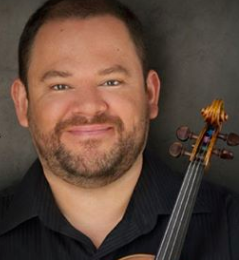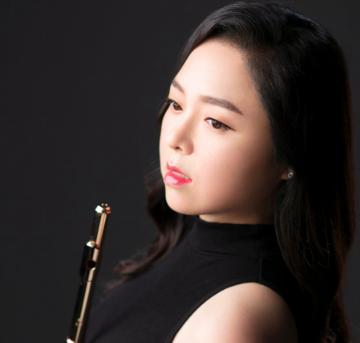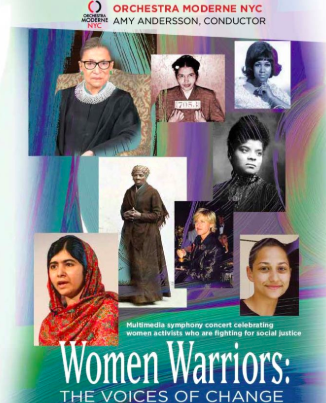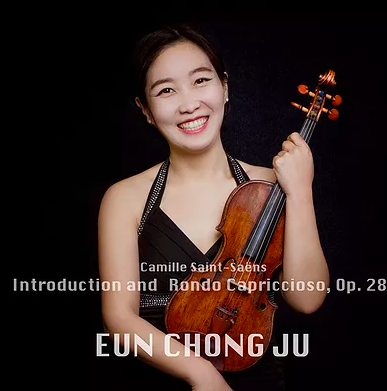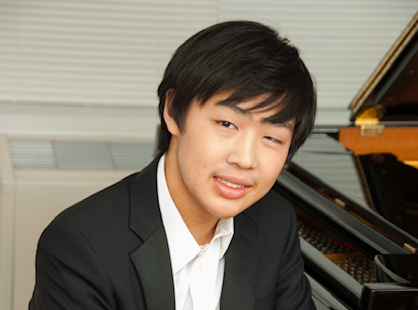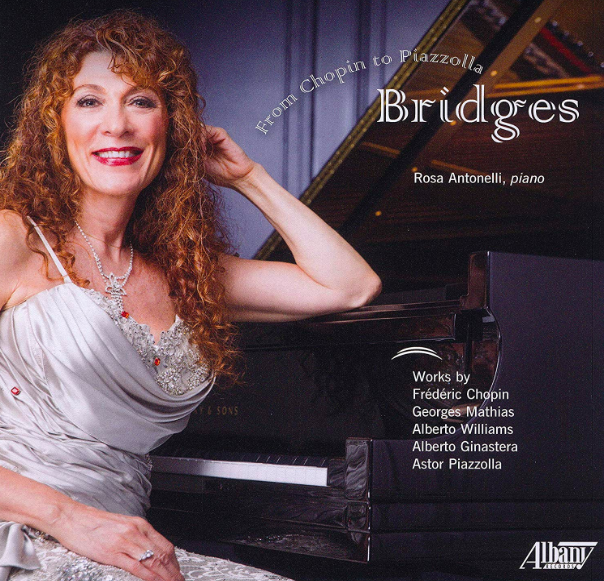Music of Frédéric Chopin, Georges Mathias, Alberto Williams, Alberto Ginastera, and Astor Piazzolla
Rosa Antonelli, piano
Recorded by Max Ross, April 2019 at Systems Two, New York, NY;
Mixed and Mastered by Mike Marciano
Cover Photo: Chris Lee
Albany Records TROY1783 (2019)
Argentinian pianist Rosa Antonelli, whom I had the pleasure of reviewing favorably in 2016 at an Alberto Ginastera Centennial concert, has come out with a fascinating new themed program on a CD entitled “Bridges.” It includes five composers, starting with Chopin and continuing with four subsequent composers (linked directly or indirectly to Chopin) whose music over the course of five generations helped to build an Argentinian style of piano composition – Georges Mathias, Alberto Williams, Alberto Ginastera, and Astor Piazzolla.
Ms. Antonelli describes in her own words the origins of the project, involving its underlying Romanticism: “It all started at my last concert at Carnegie Hall when Susan Bush, president of Albany Records, who was in the audience, came backstage after the recital and said, ‘When you played Chopin as an encore, I heard Piazzolla’s music – it’s all romantic!’ I heard similar comments from others in the audience, and I’ve felt the same for many years.” The “Bridges” CD was thus born – referring not just to diachronic bridges but to bridges between nations and cultures. Ms. Antonelli extends this concept stating that, “when we create art, we all do it together, building bridges across borders.”
Though the bridge theme is appealing, the draw for this listener was the inclusion of two composers, Georges Mathias (1826-1910) and Alberto Williams (1862-1952), both largely unknown or forgotten throughout much of the world (though highly regarded in their lifetimes) and both heard here in five world premieres (bringing the CD premiere tally to seven, counting two Piazzolla works premiered in piano versions). I couldn’t wait to hear these rarities! In many cases, the rediscovery of long-lost music can yield disappointment (as some have said, many things are forgotten for a reason); in this case, though, while I can’t profess undying love of Georges Mathias (yet), the music of Alberto Williams here has definitely opened doors of discovery, and I am holding out hope for further appreciation – more on that later.
As far as Ginastera (1916-1983) and Piazzolla (1921-1992) go, Ms. Antonelli has for many years performed music of these celebrated composers, and she does so with flair and sensitivity. Highlights of the CD for this reviewer included Ms. Antonelli’s Danza del Trigo (“Dance of Wheat”) from Ginastera’s Estancias, played with such haunting beauty that it seems reason enough on its own to purchase the CD. Interestingly, as I looked over my review of Ms. Antonelli’s 2016 Ginastera concert (Rosa Antonelli in Review), I saw that her performance of the Danza del Trigo affected me similarly then then as well.
To return to the CD as a whole, it is beautifully planned to form over 75 minutes of lyrical and atmospheric piano selections that are simpatico despite geographically diverse histories. It opens with a thoughtfully conceived group of Chopin selections, from the opening C-sharp minor Nocturne (posthumous) to the same composer’s F-sharp Nocturne Op. 48, No. 2, and on to the Waltz in G-flat (Op. 70, No. 1) in the enharmonic major. The three make quite a compatible grouping mood-wise and key-wise, and one appreciates the artfully planned sequence as well as the overall emphasis on lyricism.
These Chopin works have a distinguished performance history, so inevitably there are some quibbles, including excessive liberties with the score. Those who are not professional musicians may want to skip the rest of this paragraph, but for a musician familiar with the opening Nocturne there was too much stretching and shortening of note values beyond what might be considered justifiable (yes, there is rubato in Chopin, but the German Augmented sixths in the second and fourth measures of the opening Nocturne are nearly double in value here). In general, Ms. Antonelli is quite a persuasive interpreter, but such discrepancies with Chopin’s manuscript and respected editions are distracting, including the substitution of F-sharps in the left hand at measure 8 where the manuscript has D-sharps, some added and omitted notes, and significant changes of melody and harmony at measure 26 (though the latter change does appear in an Alfred Cortot edition). Added bass octaves in measure 59 and in the very last measure seem to “gild the lily” as well.
All quibbles aside, Ms. Antonelli establishes with flair the Chopin premise for the disc, and if the Waltz in G-flat has a measured feel that keeps it from taking its usual flight, it still serves as a good aural backdrop for the pieces of Georges Mathias that follow.
The music of Mathias (who studied with Chopin and later taught at the Paris Conservatoire) is represented here by his Romance sans Paroles, Op. 18, No. 4 and his Caprice-Valse, Op. 38, No. 1. The Romance (from the 1850’s) is full of the sentimental sighing motives and plaintive chromaticism that characterize much salon music of the time. Ms. Antonelli proves herself to be an ardent advocate for it, and one is grateful for her work in unearthing it, even if its chief interest may ultimately lie in its being the work of one of Chopin’s pupils. The rather coquettish Caprice-Valse (from c. 1865) is another kind of Victorian bonbon one rarely hears today. After a teasing introduction featuring more of the descending minor seconds that pervade the Romance (interesting segue!), the main allegretto begins with some of the feathery pianism that must have tickled salon-goers in the day. Some of it sounds a bit staid to modern ears, and this reviewer did wonder whether a lighter fleeter approach might not enliven it – but then again critiques must be balanced with gratitude for the unearthing. One’s curiosity was certainly piqued to explore this composer further.
In that spirit of exploration, a score for the Caprice-Valse was found online (Heugel edition), and one did notice that Ms. Antonelli has omitted quite a lot of notated ornaments in it, including the first page’s chain of grace notes, which would have probably lent the music a more playful character. One assumes that there was some compelling reason for such edits, as, despite stated themes relating to bridges and borders, there are some individual boundaries to a composer’s own creative realm, established largely through such notation! Mr. Mathias was certainly no stranger to matters of notation, as he was also a professor who taught piano to the next featured composer of the CD, Alberto Williams.
Buenos Aires-born Alberto Williams is described in the liner notes (credited to J. Michael Allsen) as “a leading figure in Argentina for over 50 years,” and he had become a pupil of Georges Mathias at age 20 (1882) on scholarship at the Paris Conservatoire before returning to his native Argentina in 1889. To those who read great importance into pedagogic lineage, Alberto Williams could be considered a “grand-pupil” of Chopin, or as Mr. Allsen puts it, “the keystone of this arch” from Chopin to later music of Argentina. Representing Alberto Williams here are three works, starting with the somber Valse, Op. 29, No. 3, chosen from a set of pieces for young players (1891). The Valse reflects perhaps the academic strictures of Williams’ composition teacher, César Franck, more than any pianistic gifts from Chopin’s legacy (aside from one lyrically rhapsodic episode), but considerably more substantial is Williams’ Novelette, Op. 8 (from 1886), not specified for students and more ambitious pianistically. It may owe its inspiration (and name) to Schumann, but it remains a youthful effort.
The greatest individuality by far emerges from Williams in his Huella, Op. 46, No. 1, dating from 1904, around fifteen years after the composer’s return to Argentina. Here, at last, is a distinct voice. There are, as the liner notes describe, “two alternating sections of music, one pounding out the characteristic 6/8 rhythm of the folk huella and a second featuring a more gentle alternation of duple and triple meter.” Here are the beginnings of an Argentinian piano style that surely helped to usher in Ginastera and Piazzola. It is fresh, colorful and original, and it whetted one’s appetite for more. Perhaps there will be a “Bridges II” CD with more of this composer’s later music. Beyond this, perhaps Ms. Antonelli will help to produce an international edition, as it is currently difficult, if not impossible, to obtain much of Alberto Williams’ music in the US.
Though Alberto Ginastera needs little introduction, it was particularly eye-opening to rehear some of his music after some music of Alberto Williams, his teacher during conservatory years in Buenos Aires (before Copland in the US). There is definitely a bridge here which Ms. Antonelli helped to make audible and which warrants deeper study. In addition to the stunning Danza del Trigo there is magic in the twilight romance of Idilio crepuscular and the driving dance Pequeña Danza with the spirit of the gaucho, here a bit more restrained than one is accustomed to hearing.
Six of Ginastera’s Twelve American Preludes follow, including Sadness, Vidala, Homenaje a Robert Garcia Morillo (composer and critic), Pastorale, Homenaje a Juan José Castro (conductor and composer), and Creole Dance. Highlights included the hypnotic Pastorale and the “tempo di tango” of the subsequent Castro tribute. The final rustic dance finds Ms. Antonelli unleashing more energy than in her other selections, before the Ginastera group closes with the despairing Milonga, an effective transition to the more popular genres of Astor Piazzolla, who is the next and final of the five composers.
There seems little left to explore in the increasingly popular work of Piazzolla, but his Balada para un Loco (“Ballad for a Fool” – slow tango) is captivating in Ms. Antonelli’s hands, as is the very famous Oblivion which follows. Premieres of two “new” (for piano) pieces close the CD, including La Partida (“The Parting” – a zamba) and a piece in candombe form entitled Yo soy el Negro (“I am the Black Man”). These latter two are atmospheric pieces, but with a great degree of repeating rhythms and motives which become taxing to one accustomed to truly focused listening. Perhaps the latter is hard to sustain without lyrics, but for those who seek simply some gently ambient Argentine music, it should fit the bill.
All in all, there is much to enjoy here. The CD is available at Amazon.com, AlbanyRecords.com, ArkivMusic.com, and iTunes.
by Rorianne Schrade for New York Concert Review; New York, NY


